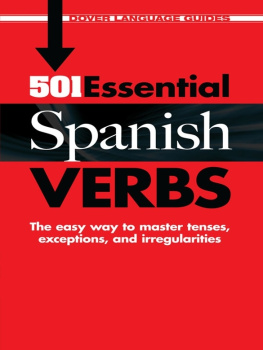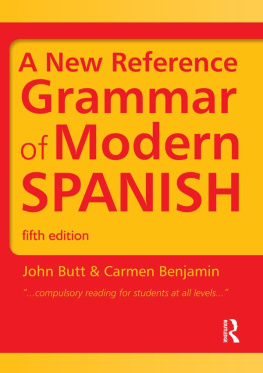1001
Most Useful
SPANISH
Words NEW EDITION Pablo Garca Loaeza, Ph.D. DOVER PUBLICATIONS, INC. Mineola, New York Copyright Copyright 2013 by Dover Publications, Inc. Text copyright 2010 by Pablo Garca Loaeza, Ph.D. All rights reserved. Library of Congress Cataloging-in-Publication Data Loaeza, Pablo Garca, 1972 1001 most useful Spanish words / Pablo Garca Loaeza.New ed. p. cm. 1001 Most Useful Spanish Words New ed., first published by Dover Publications, Inc., in 2013, is a new selection of material from 2,001 Most Useful Spanish Words, published in 2010 by Dover Publications, Inc. eISBN-13: 978-0-486-26132-4 1. eISBN-13: 978-0-486-26132-4 1.
Spanish languageVocabulary. 2. Spanish languageUsage. 3. Spanish languageGrammar. Title. II. II.
Title: One thousand and one most useful Spanish words. III. Title: 2,001 most useful Spanish words. PC4445.L623 2013 468.2'421dc23 2012021716 Manufactured in the United States by Courier Corporation 49899901 www.doverpublications.com ContentsIntroduction This book contains well over one thousand useful Spanish words for general communication and everyday situations. It was designed as a self-teaching tool that can also be used for reference and review. An m. or an f. after a noun indicates whether it is masculine or feminine; the abbreviation pl. stands for plural. stands for plural.
Many of the entries include a noun or adjective in parentheses to show the versatility of a specific word. In the second part of the book you will find words grouped by categories. These are very common words whose context is self-evident such as numbers, colors, stores, and days of the week; they are not repeated in the alphabetical section. The book takes into account Spanish dialectical variation by including words used in Spain (Sp.) and Latin America, Mexico, Argentina (L. Am., Mex., Arg., etc.). Vocabulary is best acquired in context and through frequent repetition.
When you study the words in this book, picture yourself in the situations in which you might use them. The sentences provided will help you to imagine an appropriate context. Say them out loud to practice hearing and producing the sounds of Spanish. The more familiar they become, the easier it will be for you to understand and be understood when speaking with others. Use the words you learn as often as you can so that they stick and become your own. The illustrative sentences are deliberately simple.
As you study a word in a sentence, look at the words around it to discover the way Spanish is structured. In time, you will learn to recognize several basic structures and rely increasingly less on the English translation. After a while, cover the English sentences with a sheet of paper, try to figure out the meaning of the Spanish sentences on your own, and then uncover the English version to check for accuracy. With some practice you will find that your translation is correct more often than not. While practice is always the best way to master a language, many people may find Dovers Essential Spanish Grammar (0-486-20780-3) helpful. A Note on Spanish Dialects As with English, there are many regional dialects of Spanish. A Note on Spanish Dialects As with English, there are many regional dialects of Spanish.
They may vary in pronunciation, vocabulary, and syntax but they are all mutually intelligible. For instance, in the Castile region of Spain a c before an e or an i sounds like th in English and the letter s is pronounced like sh. On the other hand, people in the south of Spain and in Latin America, generally make the letter c (before e or i), the letter s, and even the letter z all sound like the s in soup. Caribbean Spanish tends to drop a d between two vowels at the end of some words, as well as a final s so that cansados (tired, m. pl.) becomes cansao. Likewise, in many South-American countries the word for cake is torta, whereas in Mexico it is pastel.
In Latin America a computer is called una computadora while in Spain it is referred to as un ordenador. Nevertheless, a Spaniard, a Mexican, a Chilean, and a Dominican can engage in conversation without impediment. When Spanish is learned as a second language the choice of dialect can depend on personal interest and circumstance. For example, someone traveling to Spain might prefer to become familiar with the Castilian dialect, while someone spending time in a Latin American country will pick up the local accent and lingo. The best investment for a beginner studying stateside is to practice a neutral kind of Spanish: all the syllables in a word should be pronounced clearly, using the standard word-stress rules (see below). Once you know the basic rules, a little practice makes it easy to compensate for dialectical differences.
Remember also that the most useful words, such as por favor and gracias, are the same throughout the Spanish-speakingworld. Unlike Englishin which the same word may be written one way in Britain (colour, dialogue, emphasise, gaol) and another in the United States (color, dialog, emphasize, jail)all Spanish dialects use the same written standard. Spanish Pronunciation GuideVowels Spanish only has five vowel sounds (English has over 15!) which correspond to the five vowel letters, regardless of their position in a word. There are no silent vowels in Spanish. The five vowel sounds in Spanish are:
| a as in drama | Habla a la casa blanca. | Call the White House. |
| e as in bet | l es el rebelde Ren Prez. | He is the rebel Ren Prez. |
| i as in deep | S, viv sin ti. | Yes, I lived without you. |
| o as in coat | Los locos no son tontos. | Crazy people arent dumb. |
| u as in loop | Fui a un club nocturno. | I went to a nightclub. |
The semi-consonant
y is pronounced like
i [ee] when used as a conjunction: Pedro
y Mara (
PedroandMara); its sound softens next to a vowel (as in
yellow): Juan y
yo somos muy buenos amigos (
Juan and I are very good friends).
Consonants Spanish has basically the same consonant sounds as English.
However, there are a few particulars to keep in mind: b and v are very often pronounced the same way as in bee. c (soft), s, and z vary in pronunciation in some Spanish dialects. However, in all but the rarest cases, they can all be pronounced like the s in soft without risk of confusion. g is hard as in good before a, o, and u, but soft as the h in horse before e or i. gu is used before e and i to represent a soft g sound as in good (note that here the u does not function as a vowel; gu is a digraph in which two letters represent a single sound as in the) h is always mute as in herbs. ll is always pronounced like y as in yellow. represents a particular sound which resembles the
Next page











